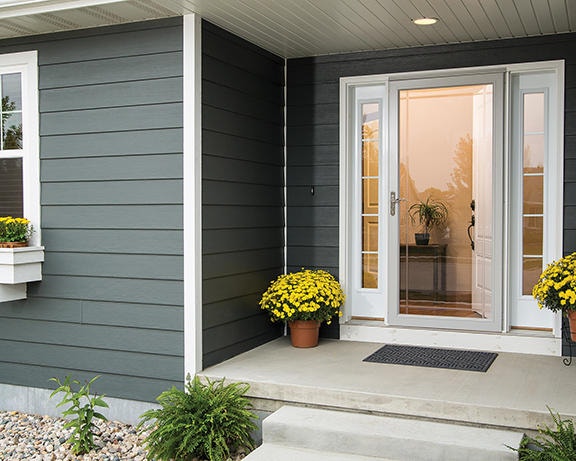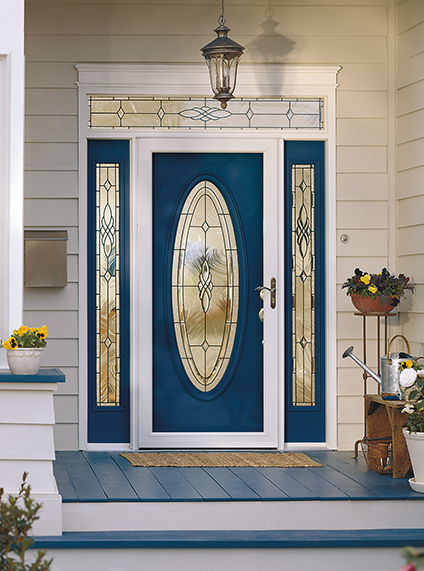How to Install a Storm Door
Even the top-performing storm door is only as good as its installation. Learn how to properly install a storm door with this step-by-step guide.

How Long it Takes:
2 to 4 hours
Level of Difficulty:
Easy
What You Need:
- Pencil
- Power drill
- ⅛ inch drill bit
- Phillips screwdriver
- Measuring tape
- Box cutter or utility knife
Time-Saving Tips for Storm Door Installation
Storm door installation is one of the easier DIY projects. Storm doors come in kits with frame parts and the hinged door, designed to make the project painless. If you’re a skilled DIYer, you can get it done in as little as two hours.
Some Pella storm door models include Pella® Express Install which eliminates the need for cutting or sawing your storm door down to size. These features help reduce installation time:
- Preassembled parts: The door, glass, screens, and rails are ready to go so you don’t have the hassle of putting everything together.
- Adjustable frame: Storm doors come in standard sizes to fit most front door frames. Extenders are included to ensure your storm door fits and operates correctly if your entry is a slightly different size.
- Pre-drilled holes: The door unit comes with holes or markers so the only pilot holes you need to drill are in the door frame on your home.
Start by learning how to measure a storm door and double check with the labels on the packaging that your new door is the right size. Then, gather your tools, lay the door flat, open the box, take an inventory of parts and get ready to begin.
Every front door is different. The general instructions below are geared towards entry doors with the factory brickmould option. Always refer to the Pella Owner’s Guide and Installation Manual that came with your door for specific instructions for your model. But for many projects, storm door installation boils down to eight easy steps.
Step 1: Line up the hinge rail on the door frame
The most common way to hang a storm door is with the hinges on the same side as your front door. This way, when you open your front door, the handle for the storm door is right where you’d expect it. It’s more convenient and more efficient for your family and guests, especially if your front door gets heavy traffic or you have your hands full.
To get started, place the hinge mounting rail on the inside of your door frame or brickmould, as indicated in the applicable instructions. Use a pencil to mark a spot in the middle of the top hole on the rail. Predrill a hole and insert a placement screw. Don’t screw it in all the way — leave space so your mounting rail can slide underneath. You’ll secure it later.
Step 2: Attach the hinge rail to the storm door panel
Starting at the top of your storm door, align the hinge rail with the interior side facing up so that the hinges match up with the hole markers on the door. Drill a pilot hole and attach the top hinge with a hinge screw.
Start at the bottom of the door and work your way back to the top, drilling the remaining pilot holes where the hinges line up and inserting the screws to secure the hinge rail. Slide the rail extender into the bottom of the hinge rail. Make sure you use the right one — they are marked “L” and “R” for left- and right-hinged.
Step 3: Hang the storm door
Slide the top of the hinge rail over the top placement screw you installed previously. Screw it all the way in to secure the storm door while pushing up so that the hinge rail is tight against the top of the door frame.
Once your hinge rail is aligned, pre-drill the bottom hole and insert a screw. Extend the rail extender down so it meets the bottom of the door frame. Drill the remaining pilot holes and install the remaining screws to secure the hinge rail to the frame. Then, do the same on the outer side of the hinge rail.
If your storm door came with weatherstripping, cut it to length with a box cutter and stick it along the hinge rail to create a protective seal. Weatherstripping your storm door helps keep precipitation and hot or cold air out of your home.
Step 4: Install the drip cap at the top of the frame
Line up the end of the drip cap with the end of the hinge rail you just installed. Close and open the door to make sure it operates smoothly. You want there to be consistent clearance at the top. Drill pilot holes following the markers on the drip cap and attach it to the frame with screws.
If your front door is not under an awning or overhang, you may want to seal the top of the storm door drip cap with caulk to prevent rain from dripping down the interior of your storm door.
Step 5: Mount the latch rail
Slide a rail extender all the way into the bottom of the latch rail. Place the latch rail along the frame, flush with the drip cap and aligned at a 90-degree angle. Then, move the rail extender back down until it meets the door frame.
Again, close and open the storm door a couple times to check for proper operation. The door should close freely without catching on the latch rail. Starting at the top, drill the pilot holes and the screws to attach the latch rail to the frame. Apply weatherstripping just as you did for the hinge rail, if necessary.
Step 6: Install the door handle
There’s a handle template already affixed to the door for your convenience. Drill holes on each side of the door following the template. Don’t drill in too far — you don’t want the hole to go all the way through. Once you’re done drilling the holes, remove the template and begin installing your storm door hardware.
Handles aren’t a standard part of the storm door, so the steps to install your hardware depends on the style and model you chose. Refer to the instruction manual that came in your handle set packaging for proper installation.
Step 7: Attach the expander underneath the storm door
Slide the expander on the bottom of your storm door and adjust it so that the sweep touches the threshold. Test the door to make sure it opens and closes smoothly. Move the expander up slightly if it’s catching. Then, drill the holes with a 3/32-inch bit and secure the expander with screws.
Step 8: Install the storm door closer
Most storm doors have door closers that control the door so it doesn’t slam shut. They may be at the top or bottom, or even both.
For a bottom door closer, place the jamb closer bracket on the hinge side of your door, even with the top of the expander. Use a pencil to mark hole placement and pre-drill 1/8-inch holes into the storm door. Attach the jamb closer bracket to the door with screws.
Attach the door closer to the jamb closer bracket and the other door closer bracket. Close the storm door and line up the door closer bracket so it’s parallel with the opposite bracket and the top of the expander. Mark the pilot holes with a pencil, pre-drill the holes and secure the door closer bracket with screws.
With a top door closer, you don’t have the bottom expander as a guide. Instead, install the jamb closer bracket so that it’s 1/4 inch away from the mounting frame and it has enough clearance to operate. Then follow the same process for attaching the door closer.

Installing a storm door isn’t something most people do every day, but it is a doable project that even beginner-level home improvers can manage. To reap the full benefits of a storm door, such as improved energy efficiency and more natural light, keep in mind that even the top-performing storm door is only as good as its installation. With that said, take your time to ensure quality work and proper installation.


